If you’re on the lookout for top bonsai choices for low light spaces, you’ve got some excellent options! The Ficus Bonsai is a real champ, thriving without a lot of sunlight. Jade Bonsai, another gem, stores moisture in its fleshy leaves, so you don’t have to fuss too much over watering. And let’s not forget the Carmona Bonsai with its delightful flowers. Intrigued by more insider tips on these enchanting little trees? Let’s explore further!
Quick Takeaways
- The Ficus Bonsai is highly resilient, thriving in low light and requiring just 3 to 5 hours of indirect sunlight daily.
- Jade Bonsai tolerates low light and is forgiving with watering, making it suitable for various indoor conditions.
- Carmona Bonsai is low-maintenance, adapts well to bright, indirect light, and can thrive in warm, humid environments.
- Ponytail Palm is drought-tolerant, low-maintenance, and easily adapts to low-light spaces, requiring minimal attention.
- Dwarf Pomegranate provides visual appeal with its unique trunk and stunning blooms, thriving in lower light conditions as well.
Ficus Bonsai: The Resilient Indoor Companion
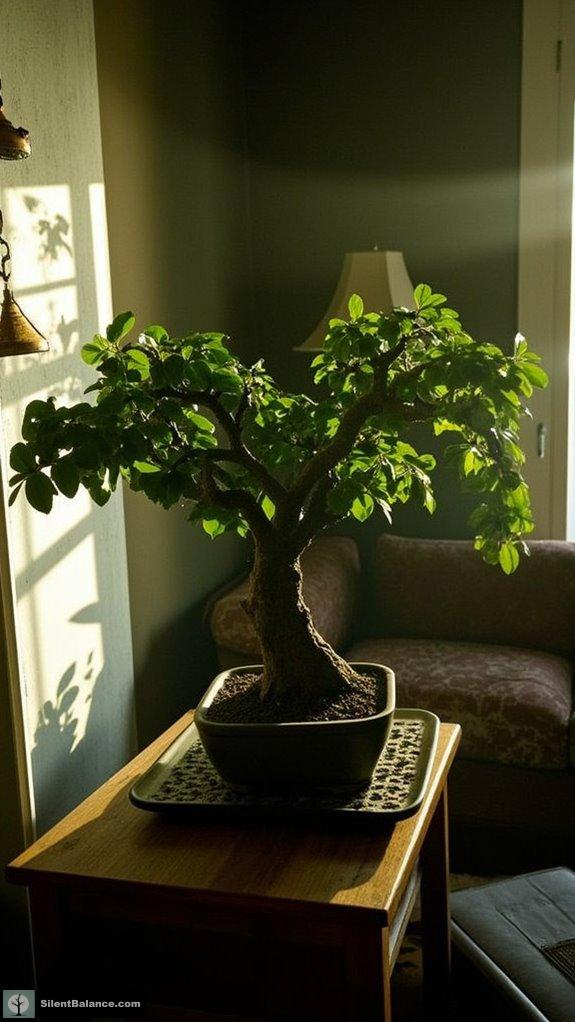
When it comes to indoor bonsai, the Ficus bonsai stands out as the resilient champion of low light spaces. I mean, who doesn’t love a tree that can hang tight in dim areas while still showcasing that lovely, lush foliage? To keep your Ficus thriving, aim for 3 to 5 hours of indirect sunlight daily—think bright, cozy corners, not direct afternoon rays that can fry those tender leaves. The Golden Gate variety is particularly well-suited for indoor growth and is known for its Vastu bonsai benefits that can enhance your living space positively.
Watering? Keep the soil moist but don’t drown it; trust me, nobody likes soggy roots! And if humidity dips, maybe try that nifty humidity tray trick. Honestly, caring for a Ficus can feel like nurturing a little green friend; you just have to show it love and watch it flourish!
Jade Bonsai: The Slow-Growing Stalwart
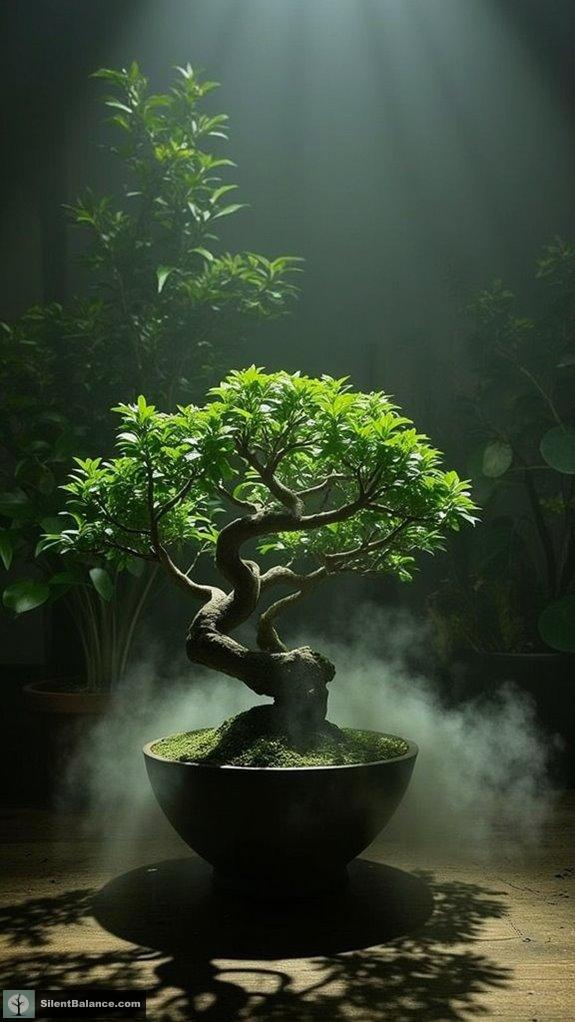
Looking for a bonsai that can handle the occasional dim light while still being a total show-off? Let me introduce you to the Jade Bonsai, or Crassula ovata.
This beauty thrives in bright, indirect light but can tolerate lower light situations—if you’re okay with a bit of leggy stretch. Just keep in mind, no overwatering! These succulent wonders store moisture in their plump leaves, so a little drought won’t hurt. Interestingly, the Jade Bonsai can adapt to specific light conditions, which allows it to survive in environments with less sunlight.
With careful pruning, you can maintain that compact bonsai style we all love, while gently coaxing branches into shape. Although it’s slow-growing, the Jade’s charm lies in its resilience, as it requires 4-6 hours of direct sunlight daily for optimal health.
Patience is key, my friend!
Carmona Bonsai: The Tropical Classic
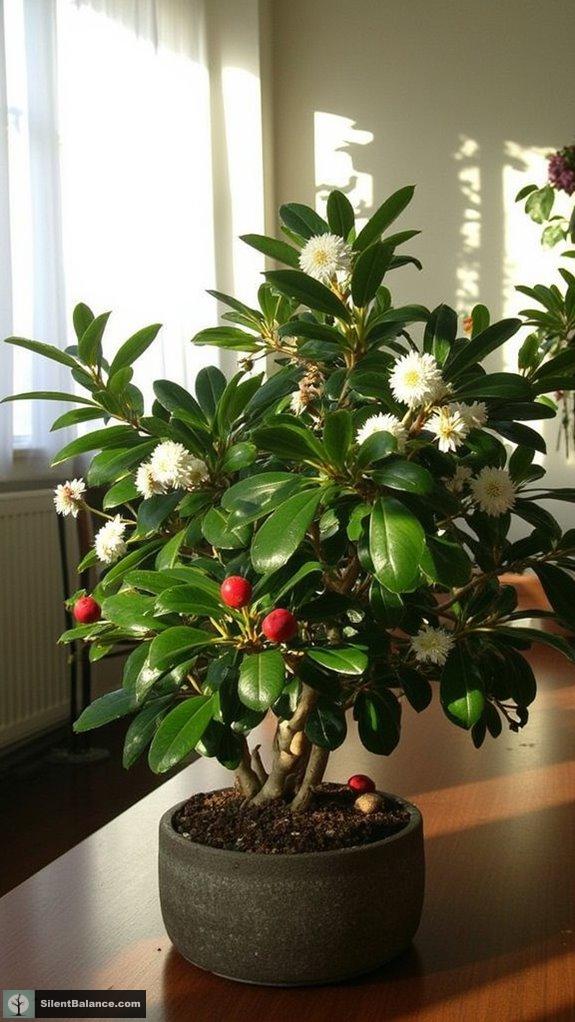
Immerse yourself in the enchanting world of Carmona bonsai, and you’ll quickly see why this tropical classic is a favorite among bonsai enthusiasts.
With those shiny, dark green leaves and delicate white flowers blooming in late spring, it’s hard not to fall in love. Plus, wait until you see those tiny red fruits pop up after flowering!
This little gem thrives in warm, humid conditions and loves bright, indirect light. Picture it basking in a south-facing window.
Don’t fret—it’s forgiving and low-maintenance, making it perfect for beginners. Just keep in mind, after some careful pruning and wiring, your Carmona can flaunt its old-world charm—and you’ll feel like a bonsai wizard.
What more could we want?
Dwarf Pomegranate: The Decorative Showstopper
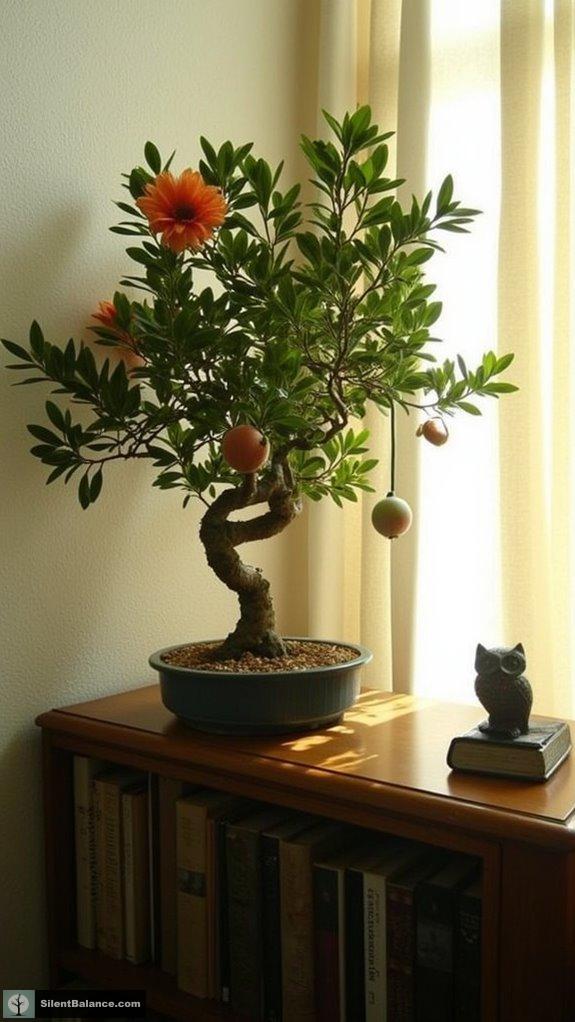
Have you ever thought about how cool it’s to have a bonsai that not only looks amazing but also produces tiny, edible fruits? The Dwarf Pomegranate is just that—an absolute showstopper!
Here’s what you’ll love about it:
- Stunning orange-red blooms from spring through summer, adding vibrant pops of color.
- Small, tasty fruits that ripen in late summer, perfect for a nibble or two.
- Glossy, dark green leaves that catch the light beautifully.
- A naturally twisting trunk that makes this bonsai a sculptural masterpiece.
This little gem not only brings beauty to your space but also makes you feel like a bonsai wizard every time you see it thriving! How delightful is that?
Ponytail Palm: The Low-Maintenance Friend
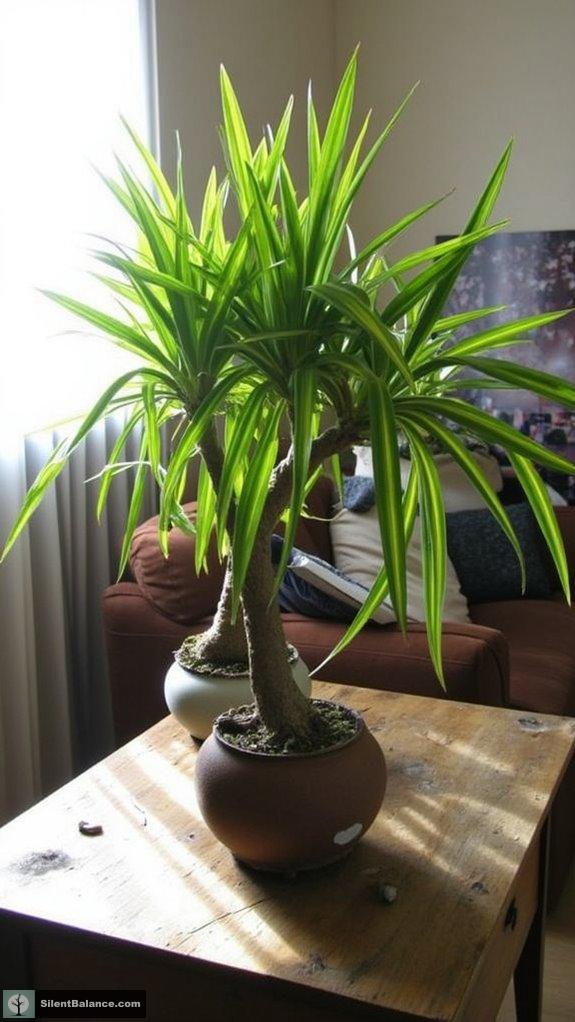
If you’re searching for a bonsai that practically begs for minimal attention while still being a showstopper, the Ponytail Palm (Beaucarnea recurvata) is calling your name!
With its bulbous trunk and long, drooping leaves, it’s like the laid-back friend who always looks fabulous, even when skipping a hair wash.
Native to southeastern Mexico, it’s not even a true palm, but who cares? It’s drought-tolerant, so you can forget about watering for up to four weeks—life’s too short for constant plant worry, right?
Place it in low light, and it’ll thrive like a boss.
Plus, its unique shape means each Ponytail is a one-of-a-kind gem.
Ready to invite this low-maintenance buddy into your home?
Bonsai Tree Symbolism
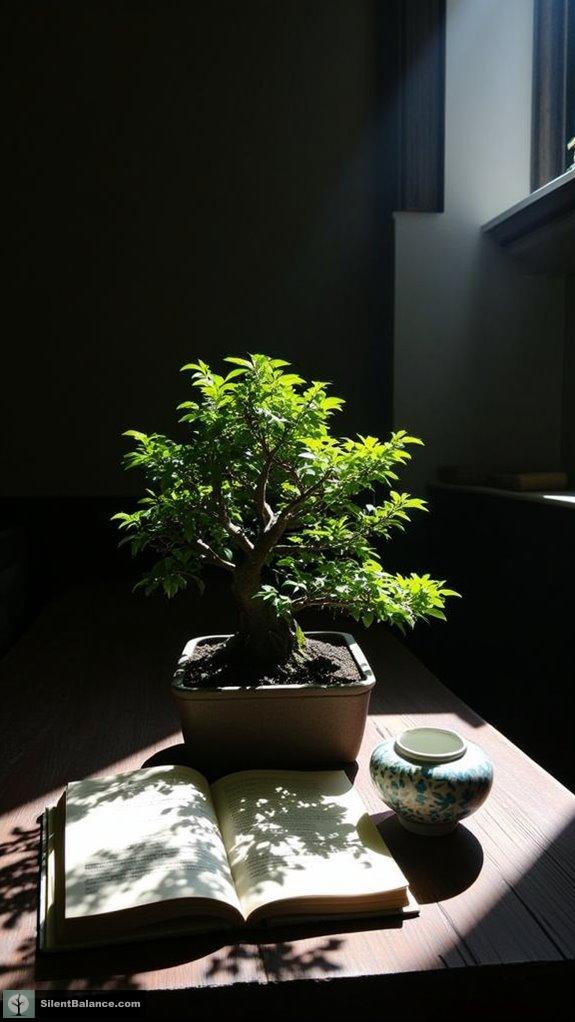
Bonsai trees are more than just artistic miniatures; they encapsulate profound meanings that resonate deeply with enthusiasts. Each tree tells a story, layering beauty with symbolism that’s hard to ignore.
Here are a few key meanings I find inspiring:
- They symbolize harmony, peace, and balance, offering a slice of nature’s goodness to your space.
- Bonsai embody patience, reminding us that growth takes time—just like nurturing friendships.
- Many species represent life’s transitory nature, with azaleas speaking to love and pines echoing resilience.
- They serve as mindful companions, inviting contemplation and inner calm amidst life’s whirlwind.
Tree Symbolism
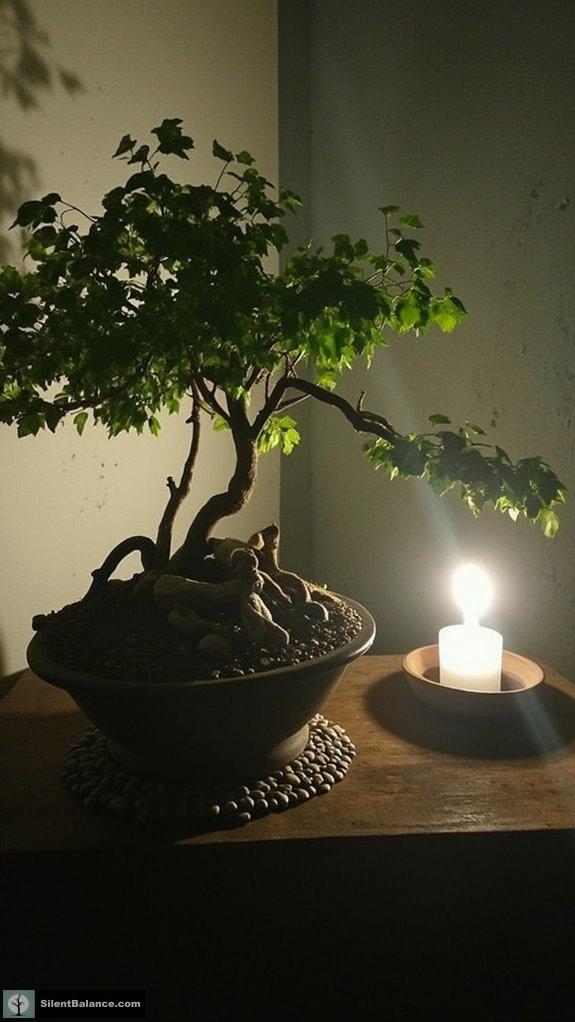
Tree symbolism is a fascinating topic that invites us to contemplate the deeper meanings woven into the very fabric of nature.
In the bonsai world, these miniature trees represent harmony, balance, and the nurturing spirit we share with them. Isn’t it comforting to think of the peace they bring to our homes?
With their Zen-influenced simplicity, they embody patience and diligence, reminding us that growth takes time and care.
I can’t help but smile at the idea of giving a bonsai as a gift, showcasing respect and admiration for someone special.
Plus, bonsai serve as spiritual guides, helping us bridge the gap between our busy lives and deeper reflections.
Why not let one of these beauties bring a little serenity into your space?
Questions and Answers
How Often Should I Fertilize Low Light Bonsai Trees?
Wondering how often to fertilize your low light bonsai trees? I usually fertilize every 4-6 weeks during spring and summer, but I keep it lighter in fall, adjusting based on how my tree responds.
Can Low Light Bonsai Survive in Dark Rooms?
I’ve found that low light bonsai can only survive in dark rooms for a few weeks. Without any light, they weaken quickly. It’s essential to provide at least some indirect light to keep them healthy.
What Soil Type Is Best for Low Light Bonsai?
I’ve found that a mix of Akadama, pumice, and lava rock works wonders for low light bonsai. It maintains moisture without waterlogging, ensuring my trees thrive even in those dimly lit corners of my home.
How Do I Identify Stress in Low Light Bonsai?
Identifying stress in low light bonsai is like spotting a friend’s sadness. I look for yellowing leaves, wilting, and stunted growth. Regular checks keep me attuned to their health, ensuring they thrive in dim conditions.
Are Any Low Light Bonsai Species Pet-Safe?
I love low light bonsai that are pet-safe like the Ponytail Palm and Money Tree. They’re perfect for my home, keeping my furry friends safe while adding some greenery. You’d enjoy them too!
References
- https://bonsai2u.co.uk/how-much-sun-does-a-bonsai-tree-need/
- https://www.lovemybonsai.com/blogs/bonsai/7-indoor-bonsai-trees-that-thrive-in-low-light-environments
- https://www.bonsaify.com/blogs/news-and-more/bonsai-tree-species-that-can-live-on-your-office-desk
- https://www.bonsaiempire.com/tree-species/indoor-bonsai
- https://www.bonsaiempire.com/forum/help-me/8630-lots-of-shade-some-indirect-sunlight
- https://www.bonsaioutlet.com/golden-gate-ficus-care/
- https://www.bonsaiempire.com/forum/help-me/10570-light-requirements-for-a-bonsai-ficus-retuna
- https://www.bonsaiempire.com/tree-species/ficus
- https://www.idyl.co.in/blogs/blog/caring-for-your-jade-plant-in-low-light-conditions
- https://www.livelyroot.com/blogs/plant-care/jade-plant-light-requirements
- https://www.jacksonandperkins.com/jade-bonsai/p/28768/
- https://www.bonsaiempire.com/tree-species/jade-tree
- https://www.mistralbonsai.com/en/all-about-bonsai/bonsai-datasheets/indoor-bonsai/carmona-sp/
- https://www.bonsaioutlet.com/bonsai/indoor-bonsai-trees/fukien/
- https://www.mistralbonsai.com/en/carmona-bonsai-care-and-secrets/
- https://highlandmoss.com/how-to-care-for-carmona-bonsai-fukien-tea-a-complete-guide/
- https://plantaddicts.com/tea-tree-bonsai/
- https://a-z-animals.com/plants/dwarf-pomegranate-bonsai-tree/
- https://www.elementalnursery.com/product/dwarf-pomegranate-bonsai/
- https://www.flowingwelltreefarm.com/products/dwarf-red-pomegranate-punica-granatum
- 7 Essential Tips for Selecting Outdoor Bonsai Tree Containers - September 6, 2025
- Perfect Pots for Thriving Tropical Bonsai Tree Containers - September 5, 2025
- Top 10 Bonsai Tree Designs for Miniature Home Greenery - September 5, 2025

